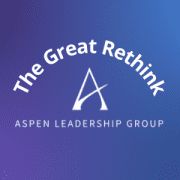Upheaval in The Job Market Presents Tremendous Opportunities for Employers and Candidates Alike
In the past couple of years, tens of millions of people have left their jobs, as changing life circumstances, declining unemployment and a tight labor market have empowered them to search for something different, something new, and depending on how you measure it, something better.
This shift has been called the Great Resignation by some. Others call it the Great Reshuffle. But those names don’t capture the true spirit behind a sudden, dramatic shift toward greater career mobility. Those monikers don’t capture the why behind the trend. We call it “the great rethink.”
 In our work, with hundreds of employers and thousands of candidates across all sectors of philanthropy, we’re seeing employees, and often employers too, completely rethink the meaning of work and career, from the ground up. Over the past two years all of us have faced a wide range of professional and personal pressures: the pandemic, social justice issues, remote work, cost of living increases, shifting wage trends, and the importance of family, to name just a few.
In our work, with hundreds of employers and thousands of candidates across all sectors of philanthropy, we’re seeing employees, and often employers too, completely rethink the meaning of work and career, from the ground up. Over the past two years all of us have faced a wide range of professional and personal pressures: the pandemic, social justice issues, remote work, cost of living increases, shifting wage trends, and the importance of family, to name just a few.
Such pressures have forced many of us to rethink what we value and why, and how our personal and professional lives knit together. That deep rethinking has spawned not just new attitudes, but action across a wide swath of the employment landscape.
For job candidates it’s easier than ever to leave a job and find a new one. Candidates are asking for and receiving: more money, more freedom, more recognition, more responsibility, a better work-life balance, and better-defined career tracks. Employers have to act decisively on candidates of interest, because the best candidates are likely being considered by multiple employers. They often drop out of a search if it takes too long or if they feel that the organization is indecisive, unclear, or unsure of what they’re seeking. For their part, employers often struggle to catch up, trying to accommodate remote work, higher salaries, more responsibility, and bigger titles, while also being fair and equitable to existing employees.
Today, the great rethink is a fact of life.
Its impacts are all around us, often necessitating some deep and pointed conversations about hiring, retention, overall staffing, and even the size and design of physical office infrastructure. And even though the world feels like it’s returning to some semblance of normalcy, we all need to recognize that many new contours of the job market will be with us for years to come, perhaps permanently:
- First, we live in a changed recruiting and retention environment that affects everybody. No one is exempt. We all have to find a productive way forward in a world that looks very different than it did just a few years ago.
- Second, we hear from employers that hiring and retention are now harder. There is little way around that reality except investing more time, effort, and resources. But candidates also need to be sensitive to the constraints of organizations as they try to evolve and adapt.
- Third, there are no quick solutions to the workplace, inclusion, and value issues that are now front-and-center in the employer/employee relationship. In fact, simplistic, blanket policies aimed at quick fixes will likely end up creating more problems than they solve.
- Finally, the implications of the Great Rethink are so deep and broad that well-meaning people will likely disagree: that has to be okay. The right path forward is often revealed only at the end of a lot of hard work, as well as sensitive and sometimes contentious conversations.
Given its permanence, we see value in delving deep into what amounts to a seismic shift in the job market, especially in the three most critical areas of change:
- workplace issues, including the viability of remote work;
- inclusion issues, such as diversity, equality, and equity (and knowing the difference); and
- value issues, i.e., how employees perceive the value of their contributions, and how employers recognize that value and motivate employees (in both monetary and non-monetary ways).
Beginning in May, and continuing for a year, we will publish a new article on the first Wednesday of each month, presenting incisive takes from ALG professionals with decades of experience in philanthropy and recruitment. Each article will be followed by a Q&A about that topic on the third Wednesday of the month, featuring leaders and emerging leaders across the nonprofit sector. Together, we will explore the most difficult topics facing employers and job seekers today, and offer practical guidance on behavior changes and action items that can help our profession navigate a changing job market.
Our goal with this series is to help our profession see that the Great Rethink can be a significant net positive for all stakeholders. It presents a huge opportunity to create greater satisfaction and productivity, for employees and organizations alike, by incorporating all that we have learned over the past several years. It’s an opportunity for a healthy rebalancing of the employee/employer relationship, to establish a strong long-term partnership that meets the goals of both.
Ultimately, those who see the Great Rethink as an inconvenience, or disruption to the status quo, along with those who try to reimpose a new status quo with superficial changes and new but rigid, one-size-fits-all policies, will likely struggle.
But we believe those who see opportunity in these changes, and take that opportunity to engage in greater dialogue and effect strategic and substantive change, will thrive. We look forward to being part of that conversation, and part of that success.
As always, please do not hesitate to reach out if you have questions or challenges where we might be able to help.
Curious to learn more? Read the next article in our series here.
Contributing author:

Ron Schiller, Founding Partner, Aspen Leadership Group


